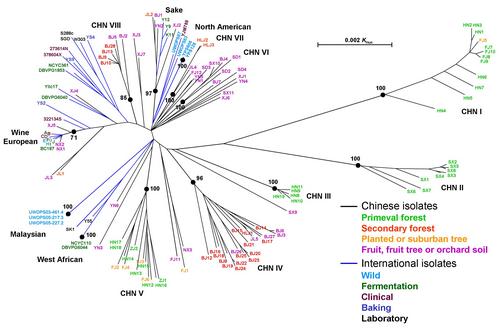The budding yeast Saccharomyces cerevisiae (S. cerevisiae) is the most commonly used microbial agent for the production of bread, beer and wine and a powerful model system in genetics, genomics and molecular biology. It has been becoming a supermodel to illuminate ecological and evolutionary principles. However, little is known about its distribution and life histories in nature.
In recent years, Professor BAI Feng-Yan’s group at the State Kay Laboratory of Mycology, Institute of Microbiology, Chinese Academy of Sciences presented a field survey of S. cerevisiae at an unprecedented scale and performed population genetics analysis. A set of international isolates from different continents representing the maximum genetic variation of S. cerevisiae documented so far were included.
The results show that S. cerevisiae is a ubiquitous species in nature, occurring in highly diversified substrates from man-made environments as well as habitats remote from human activity. Wild population of S. cerevisiae has differentiated much more greatly in nature than recognized before. Most of the wild isolates from primeval forests occurred in ancient and significantly differentiated basal lineages, while those from man-made environments usually clustered in less diverged domestic lineages or mosaic groups (see the figure bellow).
Chinese isolates of S. cerevisiae exhibited much more (nearly double) genetic variation than those from the rest of the world together. At least eight new distinct wild lineages, including the oldest lineages of S. cerevisiae recognized so far, have been identified from China. Wild close relatives of the domestic wine and sake lineages have also been recognized from the Chinese isolates.
These results show the evolutionary trend of S. cerevisiae from primeval forests to domestic environments and suggest that China - Far Eastern Asia is probably the center of diversity and origin of S. cerevisiae.
The study of Prof. BAI’s group substantially upgrades and expands the ecological and evolutionary knowledge of S. cerevisiae and present a key set of isolates with drastically expanded genetic variants for future population and quantitative genomics studies. It was published in Molecular Ecology.

S. cerevisiae phylogeny inferred from neighbor-joining analysis of the concatenated sequences of nine genes and four intergenic loci (total length of ~13 500 bp). (Image by BAI et al)
